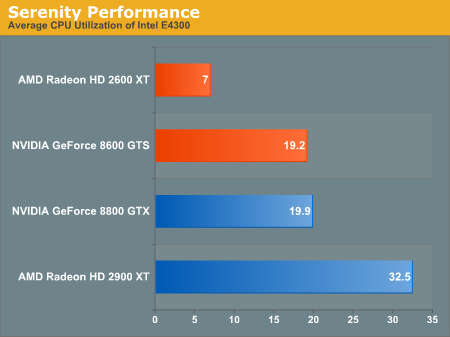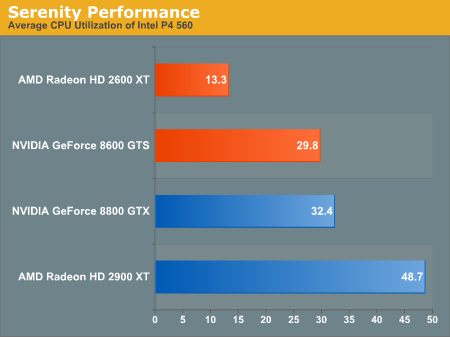HD Video Decode Quality and Performance Summer '07
by Derek Wilson on July 23, 2007 5:30 AM EST- Posted in
- GPUs
Serenity (VC-1) Performance
We haven't yet found a VC-1 title to match either of the H.264 titles we tested in complexity or bitrate, so we decided to stick with our tried and true test of Serenity. The main event here is in determining the real advantage of including VC-1 bitstream decoding on the GPU. NVIDIA's claim is that this is not as complex as it is under H.264 so it isn't necessary. AMD is pushing their solution as more complete, but does it really matter? Let's take a look.

Our HD 2900 XT has the highest CPU utilization, while the 8600 GTS and 8800 GTS share roughly the same performance. The HD 2600 XT leads the pack with an incredibly low CPU overhead of just 5 percent. This is probably approaching the minimum overhead of AACS handling and disk accesses through PowerDVD, which is very impressive. At the same time, the savings with GPU bitstream decode are not as impressive under VC-1 as on H.264 on the high end.

Dropping down in processor power doesn't heavily impact CPU overhead in the case of VC-1.

Moving all the way down to a Pentium 4 based processor, we do see higher CPU utilization across the board. The difference isn't as great as under H.264, and, not only that, but VC-1 movies appear to remain very playable on this hardware even without bitstream decoding on the GPU. This is not the case for our H.264 movies. While we wouldn't recommend it with the HD 2900 XT, we could even consider looking at a (fairly fast) single core CPU the other hardware, with or without full decode acceleration.
We haven't yet found a VC-1 title to match either of the H.264 titles we tested in complexity or bitrate, so we decided to stick with our tried and true test of Serenity. The main event here is in determining the real advantage of including VC-1 bitstream decoding on the GPU. NVIDIA's claim is that this is not as complex as it is under H.264 so it isn't necessary. AMD is pushing their solution as more complete, but does it really matter? Let's take a look.

Our HD 2900 XT has the highest CPU utilization, while the 8600 GTS and 8800 GTS share roughly the same performance. The HD 2600 XT leads the pack with an incredibly low CPU overhead of just 5 percent. This is probably approaching the minimum overhead of AACS handling and disk accesses through PowerDVD, which is very impressive. At the same time, the savings with GPU bitstream decode are not as impressive under VC-1 as on H.264 on the high end.

Dropping down in processor power doesn't heavily impact CPU overhead in the case of VC-1.

Moving all the way down to a Pentium 4 based processor, we do see higher CPU utilization across the board. The difference isn't as great as under H.264, and, not only that, but VC-1 movies appear to remain very playable on this hardware even without bitstream decoding on the GPU. This is not the case for our H.264 movies. While we wouldn't recommend it with the HD 2900 XT, we could even consider looking at a (fairly fast) single core CPU the other hardware, with or without full decode acceleration.










63 Comments
View All Comments
erwos - Monday, July 23, 2007 - link
Does it? Because I thought that was only for MPEG-2. Link?smitty3268 - Monday, July 23, 2007 - link
Most drivers only support it with MPEG-2, but that doesn't mean it isn't capable of more. Looking again, I'm a little unclear about how much work would be required to get it working. I'm not sure if it is completely done and just requires support from the hardware vendors or if it also needs some additional work before that happens.http://www.mythtv.org/wiki/index.php/XvMC">http://www.mythtv.org/wiki/index.php/XvMC
http://en.wikipedia.org/wiki/X-Video_Motion_Compen...">http://en.wikipedia.org/wiki/X-Video_Motion_Compen...
Per Hansson - Monday, July 23, 2007 - link
Hi, it would be really interesting to see similar tests done in Linux alsoFor example how cheap of a HTPC rig can you build, with free software too, and still provide betters features than any of the commercial solutions.
I think we are many that have some old hardware laying around. And when seeing this article it brings up ideas. Pairing the old computer with a (AGP?) ATI 2600 card would provide an ideal solution in a nice HTPC chassi under the TV perhaps?
jojo4u - Monday, July 23, 2007 - link
Linux is not practical. You would have to crack AACS and dump the disc first.Per Hansson - Monday, July 23, 2007 - link
Hmm, I did not realize thatHowever a HTPC can still be built to be a player for satellite data for example, granted configuring all that up with a subscription card will not be for the faint of heart. But then again the Dreambox 8000 is not available yet, only a new decoder from Kathrein UFS910 with no decent software (yet)
jojo4u - Monday, July 23, 2007 - link
Hi Derek,good review. However, based on a review of the german written magazine C't I have some suggestions and additions:
PowerDVD patch 2911, Catalyst 7.6, Nvidia 158.24
- the Geforce G84/85 miss not only VC-1 but also MPEG-2 bitstream processing.
- the HD 2400 does not have MPEG-2 bitstream processing, frequency transform and pixel prediction or it is not activated.
- A single core Athlon is significantly worse than a single core Pentium IV. The reson is AACS. Decryption puts a hudge load on the CPU and is optimized for Intel CPUs (9%->39% H.264, Pentium IV, Casino Royale). Perhaps later patches made the situation better (like your Yozakura shows?)
- VC-1 on the Radeons and Geforces showed picture distortions, but based on your review this seems to be fixed now
Combinations of Athlon 3500+, X2 6000+, Pentium IV 3,2 GHz, Pentium E2160 and HD 2400/2600, Geforce 8600 GTS which resulted in lagging in MPEG-2 or VC-1 or H.264
3500+ + 690G/2400/2600/8600
6000+ + 690G
Pentium IV + 8600
Chunga29 - Monday, July 23, 2007 - link
Why run with older drivers? If these features are important to you, you will need to stay on top of the driver game. Would have been interesting to see AMD chips in there, but then that would require a different motherboard as well. I think the use of a P4 560 was perfectly acceptable - it's a low-end CPU and if it can handle playback with the 2600/8600 then Athlons will be fine as well.8steve8 - Monday, July 23, 2007 - link
nice article..but, while i usually think anandtech conclusions are insightful and spot on,
it seems odd not to give props to the 2600xt which dominated the benchmarks.
for the occasional gamer who often likes watching videos, it seems the 2600xt is a great choice, better than the 8600gts.
for example for VC1, on a low end c2duo the difference between 7% and 19.2% matters, esp if the person likes watching a video while working or browsing or whatever...
can amd add noise reduction options later w/ a driver update?
defter - Tuesday, July 24, 2007 - link
How can that matter? Even in worst case you have 80% of idle CPU time.
Besides, how can you "work" while watching video at the same time? And don't try to tell me that a web browser takes over 80% of CPU time with Core2 Duo system...
drebo - Monday, July 23, 2007 - link
We all know why this is.
I'll give you a hint: look at the overwhelming presence of Intel advertising on this site.
It doesn't take a genius to figure it out. That's why I don't take the video and CPU reviews on this site seriously anymore.